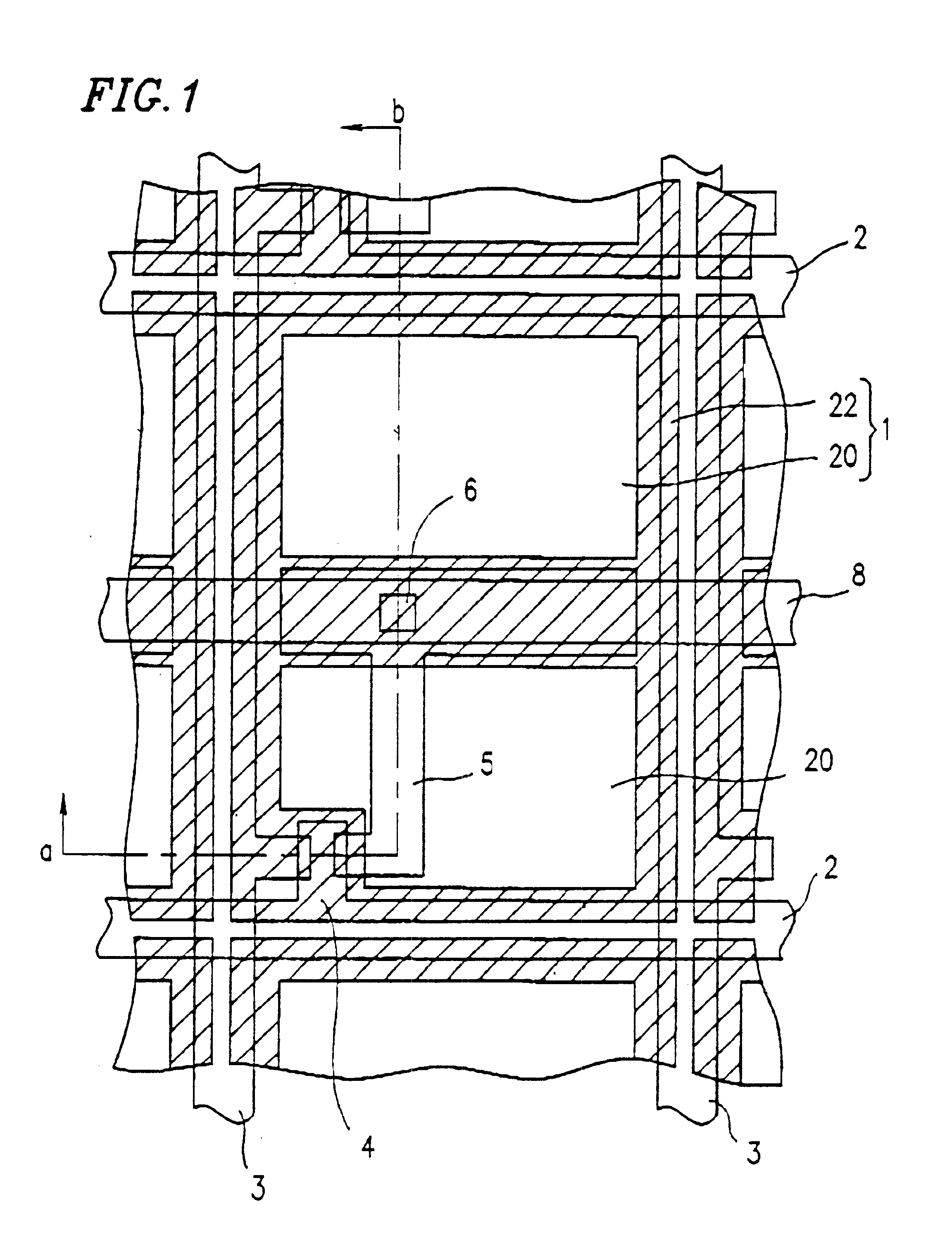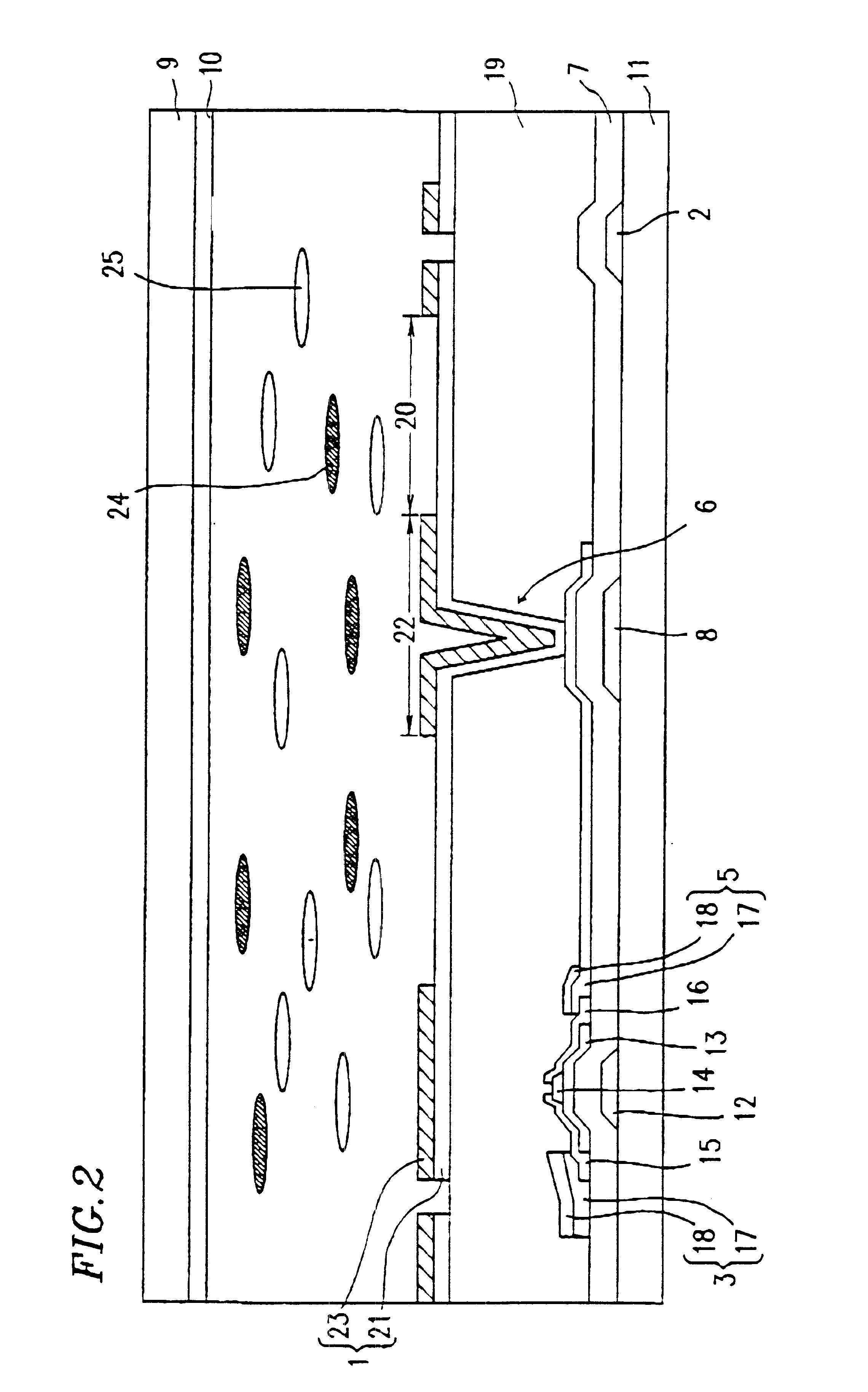Liquid crystal display in which at least one pixel includes both a transmissive region and a reflective region
a liquid crystal display and transmissive region technology, applied in static indicating devices, instruments, non-linear optics, etc., can solve the problems of backlight consumption, ambient light reflection, and 50% or more of the total power consumed by the liquid crystal display devi
- Summary
- Abstract
- Description
- Claims
- Application Information
AI Technical Summary
Benefits of technology
Problems solved by technology
Method used
Image
Examples
example 2
In Example 2, a method for forming the uneven surface of the metal film 23 will be described.
FIG. 5 is a plan view partially illustrating the metal film 23 formed on the interlayer insulating film 19 (not shown). FIG. 6 is a sectional view taken along line c-d of FIG. 5.
The surface of the interlayer insulating film 19 is made uneven by etching or the like, and the metal film 23 is formed on the uneven surface.
Thus, by forming the metal film 23 on the interlayer insulating film 19 which may be first formed flat by the spin application method or the like, but then have the surface thereof made uneven as described above, the metal film 23 having an uneven surface is obtained.
In a reflection type liquid crystal display device, the uneven surface of the metal film 23 is advantageous over a flat surface since an uneven surface receives ambient light at various incident angles. Thus, by forming the metal films 23 of the pixel electrodes 1 on the interlayer insulating film 19 so as to have ...
example 3
In Example 3, a liquid crystal display device which employs a guest-host display method will be described.
FIG. 7 is a sectional view of a liquid crystal display device of this example according to the present invention. The same components as those of Example 1 are denoted by the same reference numerals as those in FIG. 2.
When the guest-host display method is employed using a mixture of a guest-host liquid crystal material, ZLI 2327 (manufactured by Merck & Co., Inc.) containing black pigments therein and 0.5% of an optically active substance, S-811 (manufactured by Merck & Co., Inc.), the following problem arises. That is, if the optical path length dt of transmitted light from the blacklight in the transmission region using the backlight is significantly different from the optical path length 2dr of reflected light from ambient light in the reflection region, the brightness and the contrast of the resultant display are significantly different between the case where light from the ...
example 4
FIG. 8A is a plan view of one pixel portion of an active matrix substrate of a liquid crystal display device of Example 4 according to the present invention. FIG. 8B is a sectional view taken along line A--A of FIG. 8A.
The active matrix substrate of this example includes gate lines 41, data lines 42, driving elements 43, drain electrodes 44, storage capacitor electrodes 45, a gate insulating film 46, an insulating substrate 47, contact holes 48, an interlayer insulating film 49, reflection pixel electrodes 50, and transmission pixel electrodes 51.
Each of the storage capacitor electrodes 45 is electrically connected to the corresponding drain electrode 44 and overlaps the corresponding gate line 41 via the gate insulating film 46. The contact holes 48 are formed through the interlayer insulating film 49 to connect the transmission pixel electrodes 51 and the storage capacitor electrodes 45.
Each pixel of the active matrix substrate with the above construction includes a reflection pix...
PUM
| Property | Measurement | Unit |
|---|---|---|
| thickness | aaaaa | aaaaa |
| transmittance | aaaaa | aaaaa |
| transmittance | aaaaa | aaaaa |
Abstract
Description
Claims
Application Information
 Login to View More
Login to View More - R&D
- Intellectual Property
- Life Sciences
- Materials
- Tech Scout
- Unparalleled Data Quality
- Higher Quality Content
- 60% Fewer Hallucinations
Browse by: Latest US Patents, China's latest patents, Technical Efficacy Thesaurus, Application Domain, Technology Topic, Popular Technical Reports.
© 2025 PatSnap. All rights reserved.Legal|Privacy policy|Modern Slavery Act Transparency Statement|Sitemap|About US| Contact US: help@patsnap.com



